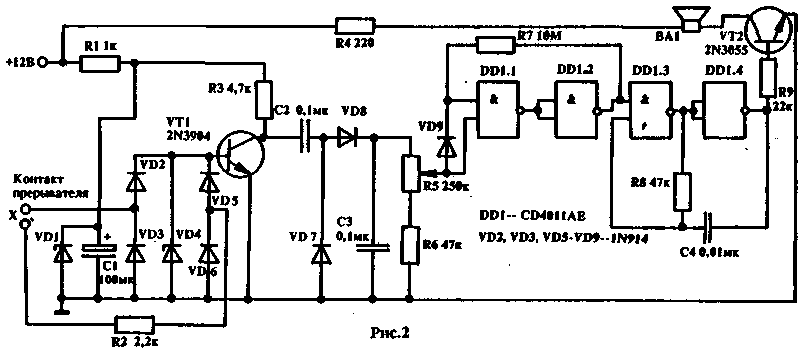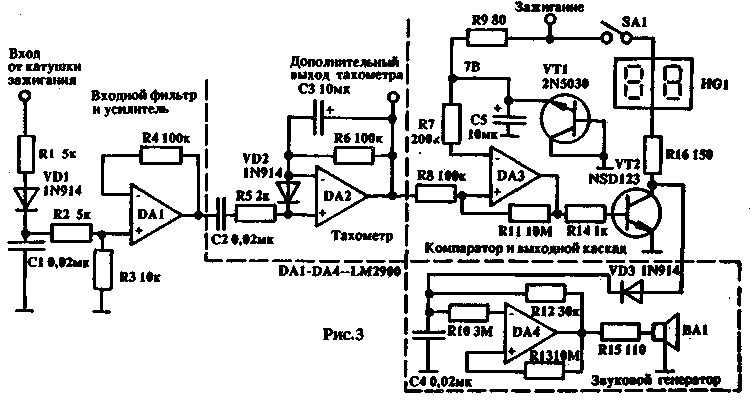One of the motorists heart ached when meeting with "electronic screens" on the instrument panels of Japanese cars. They got everything there. We would at least one button-the light bulb...
"Ham" offers a choice of several foreign electronic products that may be of interest to car enthusiasts, being able to own not only a wrench and a pry bar, and a soldering iron. Selection of materials is made up of descriptions of practical devices, the development of which contributes an American engineer Rudolf Graf and presented in his book "Electronic circuits: 1300 examples".
TACHOMETER FOR INTERNAL COMBUSTION LWИГАТЕЛЯ
This tachometer is convenient because it can be installed on the engine with any number of cylinders, only connecting to the scheme (Fig. 1) suitable ramasadaya resistors R7, R8 and R9. As an indicator measuring pointer instrument, designed for current full deflection of 10 mA. The scale of this device to calibrate the rpm.min, and a maximum limit of 6000 rpm.min.

Trimmer resistor R10 is used for the final calibration of the instrument. The scheme is protected against transient surges, consisting of resistor R5 and Zener diode VD1 from the voltage stabilization 24 V. Connection of resistors R7 - R9 with the body to produce depending on the number of cylinders of the engine, i.e. R7, R8 and R9 correspond to the four, six and eight cylinders. Domestic analogue circuits DA1, DA2 - CUT. Transistor VT1 - any low-power, silicon.
ANNUNCIATORS SPEEDING
The device is triggered, if the car speed exceeds the set point. In this case, the speaker is heard annoying sound that disappears soon after reducing speed 5 - b km/h. Diagram (Fig. 2) consists of a rectifier bridge diodes VD2 - VD6, which rectifies the pulses coming from the breaker contacts of the car, with the resulting DC voltage is limited by the Zener diode VD4 at 4.7 V. This voltage is proportional to the speed of the engine, after the transistor VT1 and diode detector VD7 - VD8 hits the potentiometer R5, which is the regulator of the threshold device. The signal controls the driver and the multivibrator logic elements DD1 chip.

The transistor VT2 boosts the signal of the multivibrator to the required extent in its collector circuit is enabled speaker BA1. Analogues CD4011АЕ are domestic digital circuits CLA and CLA. The Zener diode VD1 is the voltage stabilization 9 In type DB. All other diodes corresponds domestic analogue - KDA.

Diagram of another detector Overspeed (Fig. 3) consists of four amplifiers on a chip LM2900, domestic analogue which is a Quad operational amplifier COD. Amplifier DA1 processes the signal coming from the ignition coil. Amplifier DA2 converts the frequency to a voltage so that the voltage at its output proportional to the engine speed. DA3 compares the tachometer voltage with a reference voltage, and includes an output transistor when exceeding the set speed. DA4 is used in the oscillator circuit that generates an audible signal. The device can be applied to domestic transistors KT315. The diodes are changed on CDA.
TACHOMETER
This tachometer (Fig. 4) as the sensor pulses using a magnetic head. The signals are amplified DA1 and fed to the input waiting multivibrator elements DA2 and DA3, after which rectangular pulses through the control potentiometer R9 fall on the driver DA4 and then click on the device with a measuring scale, graduated in rpm.min chip - CUT, diodes - KDA, the Zener diode VD3 - XA.

THE FREQUENCY LWИЖЕНИЯ WIPER
The knob to windshield wiper in which scheme (Fig. 5) used the integral timer NE555V, allows you to set the duration of time intervals during which there is "swing" wiper. DA1 chip operates in resinhronizuju multivibrator. The length of the interval during which the timer is in the on state, determined by the values of C1, R2, and R3. Potentiometer R2, you can change the frequency of operation of the wiper from 2 to 15 sec. The device can be applied to domestic chip CREW. Relay with a coil resistance of the solenoid - 1200 Ohms. All diodes - KDA.

Literature
Publication: N. Bolshakov, rf.atnn.ru






